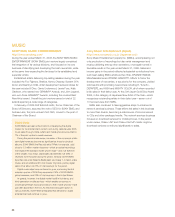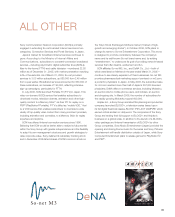Sony 2006 Annual Report Download - page 38
Download and view the complete annual report
Please find page 38 of the 2006 Sony annual report below. You can navigate through the pages in the report by either clicking on the pages listed below, or by using the keyword search tool below to find specific information within the annual report.
36
Digital Music
SONY BMG has been at the forefront of developing the digital
market for its entertainment content, and during calendar year 2005
music sales through online outlets and mobile phones accounted for
7% of the joint venture’s overall revenues.
During the period under review, a number of the company’s artists
saw digital revenues become as significant as those for physical
albums. SONY BMG/Jive Records artist T-Pain, for example, sold
close to 3.3 million master ringtones—which are actual recordings
that replace the standard mobile phone ringer—and over 929,000
online singles. As a result, digital sales represented over 49% of
revenues from this artist during the period. Similarly, SONY BMG/
Epic Records artist Natasha Bedingfield sold nearly 1.4 million online
tracks, and an additional 310,000 master ringtones, putting digital
sales of her album at 27% of total revenues for the period.
Digital music sales have continued to grow, and during the first
calendar quarter of 2006 they represented 14% of SONY BMG’s
global revenues, and 22% of total revenues in the United States.
In general, however, the digital market is still in its infancy, and
third-generation mobile services—which enable consumers to
download full-length tracks and videos to their mobile phones—have
just been launched in the U.S. As these services gain traction in
various markets, SONY BMG anticipates that demand for digital
entertainment will continue to grow.
MUSIC
SONY BMG MUSIC ENTERTAINMENT
http://www.sonybmg.com/
During the year ended March 31, 2006, the SONY BMG MUSIC
ENTERTAINMENT (SONY BMG) joint venture largely completed
the integration of its various divisions, and focused on its core
business of identifying and developing the best new artists, while
at the same time expanding the fan base for its established and
superstar artists.
Established artists delivering top-selling releases during the year
included the Foo Fighters, Shakira, Kenny Chesney, System Of A
Down and Destiny’s Child. Artist development success stories for
the year included Il Divo, Carrie Underwood, Jamie Foxx, Kelly
Clarkson, who earned two GRAMMY® Awards, and John Legend,
who won three GRAMMY® Awards, including the coveted Best
New Artist award. Overall the joint venture earned a total of 22
awards spanning a wide range of categories.
In February of 2006 Rolf Schmidt-Holtz, former Chairman of the
Board of Directors, assumed the role of CEO for SONY BMG, and
Andrew Lack, the joint venture’s first CEO, moved to the post of
Chairman of the Board.
Sony Music Entertainment (Japan)
http://www.sonymusic.co.jp (Japanese only)
Sony Music Entertainment (Japan) Inc. (SMEJ), encompassing not
only production of recordings but also artist management and
music publishing among other operations, once again turned in
favorable results in the year ended March 31, 2006. Sales and
income gains in the period reflected substantial contributions from
such best-selling SMEJ artists as Ken Hirai, ORANGE RANGE,
Mika Nakashima and PORNO GRAFFITTI. Efforts to foster the
development of new artists, a top priority for the company, yielded
solid results with promising newcomers including K, Yuna Ito,
DEPAPEPE, and HIGH and MIGHTY COLOR, all of whom recorded
brisk sales in their debut year. At the 20th Japan Gold Disc Award
2006, in the category of Japanese New Artist of the Year—which
recognizes outstanding artists in their debut year—seven out of
13 honored were from SMEJ.
SMEJ also continued to take aggressive steps to enhance its
network services business. These efforts led sales in this business
to more than double, becoming a solid source of income second
to CDs and other packaged media. The network services business
focuses on download services for mobile phones. In the period
under review, Chaku-Uta® and Chaku-Uta Full® master ringtone
download services contributed significantly to sales.
























